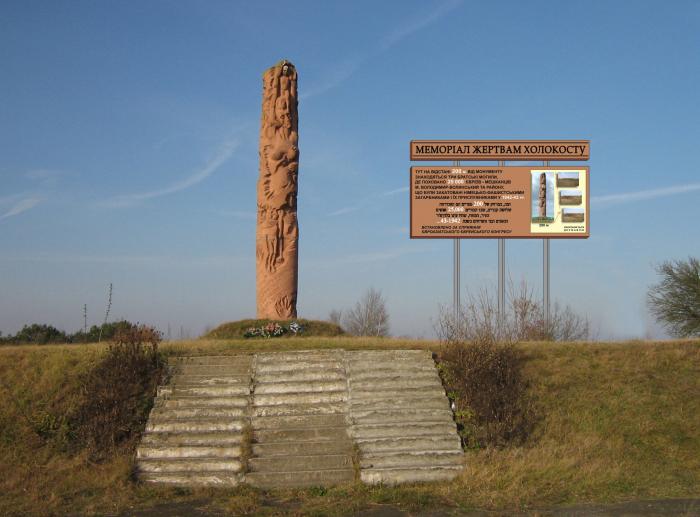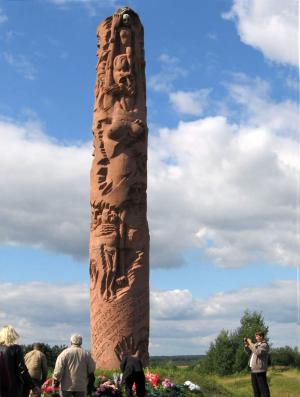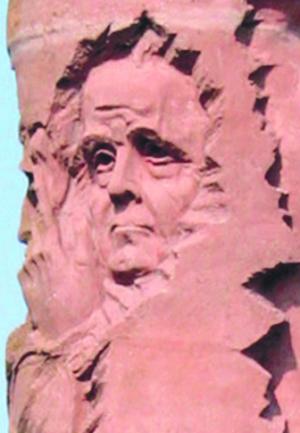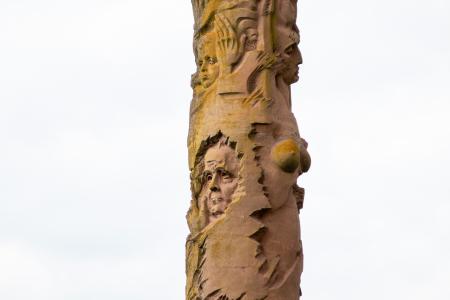Obj. ID: 49521
Memorials Holocaust Memorial in Piatydni near Volodymyr Volynskyi, Ukraine, 1989, 2010

Memorial Name
No official name
Who is Commemorated?
Jewish victims of the Holocaust from Volodymyr Volynskyi and the district
Description
This monument is located on a hill, about 300 meters north of the road between Ustyluh and Volodymyr. The mass graves are located another 300 meters north of the monument. The area around the Monument is covered with red bricks. According to Volodymyr Muzychenko, these bricks symbolize the earth covered with blood [Muzychenko, p. 210]. The monument itself is an ashy-colored polymer-based concrete obelisk 12 meters high. Stylized relief images of perished young people, old people, and children are carved on the monument. The image of a mother and child completes the composition. The monument bears inscriptions in Ukrainian, Russian, and Yiddish. The Russian text very briefly speaks about the mass murders on the site without indicating the ethnicity of the victims. The Ukrainian and Yiddish inscriptions are poetry by Yiddish poet and writer Oleksandr Lizen. In 2010, an information board was unveiled near the monument.
Inscriptions
On the monument
In Russian:
25 тысяч советских граждан
убиты здесь в 1942—1943 годах
фашистскими оккупантами
Translation: 25 thousand Soviet citizens / Were killed here in the years 1942—1943 / by the fascist occupiers
In Ukrainian
Зупинимось, помовчимо хвилину.
Свято присягаємо, жагуче,
Що муки ваші не забудемо довіку,
Всім катам покара неминуча
Translation: [We] will stop, [we] will be silent for a minute, / [We] piously, passionately swear, / that [we] will never forget your torments, / Inevitable punishment [must come] to all executioners
In Yiddish:
שטעלט זיך, מענטשן, אָפּ אף א מינוט און שווײַגט
און גיט א שוווּע, הייליקע, געטרײַ, און אײַזן-פעסט
אז קיינמאָל, קיינמאָל ניט פארגעסן וועט איר אונדזער פּײַן
און ניט דערלאזן וועט איר קיינמאָל ווידער
Translation: People, stop for a minute and be silent / and give an oath - holy, trustworthy, ironclad / [that you will] never, never forget our pain / and will never let it happen one more time
On the information board
In Ukrainian
Меморіал жертвам Холокосту
Тут на відстані 200 м [=метрів] від монументу
знаходяться три братські могили, де поховано
25 000 євреїв м. Володимир-Волинського і
району, що були закатовані нацистськими
загарбниками та їхніми прислужниками в
1942-1943 роках.
Встановлено за сприяння Євроазіатського єврейського конгресу
Translation: Memorial to the victims of the Holocaust // Here, at a distance of 200 meters from the monument, there are three mass graves, where 25,000 Jews of the Volodymyr-Volynskyi city and the district, that were tortured by the nazi invaders and their servants in the years 1942-43. // Erected with the assistance of The Euro-Asian Jewish Congress.
In Hebrew:
במרחק 200 מטר מהאנדרטה נמצאים שלושה קברי אחים אשר בהם
נקברו 000 25 יהודים מלודמיר וסביבותיה אשר ע נו על ידי הנאצים
ומשרתיהם בשנים 1943 - 1942
Translation: Here, at a distance of 200 meters from the monument, there are three mass graves; 25,000 Jews from the city of Volodymyr-Volynskyi and the vicinities, tortured by the Nazis and their servants in the years 1942-43, were buried in there.
The pictures on the information board are captioned in Ukrainian:
200 м [=метрів]
Охороняється державою
(Свідоцтво ? № 640)
Translation: 200 meters / Protected by the government / (Certificate ? no. 640)
The information board in its original version of 2010 had slightly different inscriptions:
In Ukrainian:
Меморіал жертвам Холокосту
Тут на відстані 200 м [=метрів] від монументу
знаходяться три братські могили
де поховано 25 000 євреїв - мешканців
м. [=міста] Володимир-Волинський та району,
що були закатовані німецько-фашистськими
загарбниками і їх прислужниками у 1942-43 рр.
Встановлено за сприяння
Євроазіатського єврейського конгресу
Translation: Memorial to the victims of the Holocaust // Here, at a distance of 200 meters from the monument, there are three mass graves, where 25,000 Jews, residents of the Volodymyr-Volynskyi city and the district, that were tortured by the German nazi invaders and their servants in the years 1942-43. // Erected with the assistance of The Euro-Asian Jewish Congress.
In Hebrew:
הנה, במרחק של 200 מטרים הם האנדרטה
שלושה קברים, שבו קבורים 25,000 אנשים
העיר, המחוז, שהיו עינו בלוךמ'ר
הנאצים ובני משרצים בשנת 1942-43...
[The inscription is written with numerous mistakes and looks like a word-for-word translation from Ukrainian]
Translation: Here, at a distance of 200 meters from the monument, there are three mass graves; 25,000 Jews from the city of Volodymyr-Volynskyi and the vicinities, tortured by the Nazis and their servants in the years 1942-43, were buried in there.
The pictures on the information board were captioned in Ukrainian:
200 м [=метрів]
Охороняється державою
Translation: 200 meters / Protected by the government
Most probably, the original board was replaced due to numerous mistakes in the Hebrew inscription.
Commissioned by
Unknown
Zabutyi, CC BY-SA 4.0 <https://creativecommons.org/licenses/by-sa/4.0>, via Wikimedia Commons
sub-set tree:
Diameter in base 3.5 m
Diameter at the top 1.5 m
In 1937, the Jewish population of Włodzimierz Wołynski (now Volodymyr Volynskyi) was over 11,500. On June 23, 1941, German troops entered the city. The Ghetto was established on April 13, 1942. According to different estimates, there were 15,000 - 18,000 Jews in the Ghetto. During two weeks in September 1942, Nazi Germans and Ukrainian police representatives shot about 14,000 Jews in Piatydni [Encyclopedia].
According to Volodymyr Muzychenko, local survivors erected the first monument on the killing site in Piatydni in 1944. A new monument was made in an underground effort, thanks to A. Zhornytskyi, and clandestinely installed at night in 1967 or 1971.
In the late 1980s, mass graves became the subject of attention, thanks to activities by Human Rights organizations in the USSR. The Head of the World Federation of Wolhynia Jews, Yaakov Elbirt, actively took part in this process.
After the graves were dug up due to earthworks on the territory of the burials, the representative of the President of the USSR in the Volodymyr Volynsky district, P. Sahaniuk, ordered the creation of huge mounds over the three graves, in order to level and organize the entire adjacent territory.
The Volyn Regional Executive Committee included the monument on The List of Monuments of History and Monumental Art of Local Significance by decision no. 267-р on August 25, 1986.
In 1989, the Monument was installed near the killing site. The author of the inscriptions is Oleksandr Lizen (Isroel Lizenberg), a Jewish author who wrote in Yiddish, Ukrainian, and Russian. He was born in Volhynia, was a member of the Union of Writers of the USSR, an Honored Worker of Culture of Ukraine, and founder of the Society of Jewish Culture named after Sholom Aleichem in 1988 in Lviv [Oleksandr Lizen]. Sculptor P. Flit and architect A. Rudnytskyi worked on the project for two years. The Monument was made by Lviv Art and Ceramic Factory.
On September 17, 1989, the obelisk was unveiled. The red ribbon was cut by former Ghetto prisoner M.I. Bass, Y.A. Zhornytskyi, a veteran of the WWII M.V. Rekunovych, and the first secretary of the city committee of the communist party S.V. Lesyk.
In the 1990s, the area of the mass graves was consistently littered. Some locals took sand from the territory for construction. In the spring, human bones washed out from the graves. A part of the territory was used for agriculture.
In 2008, the Representative of the American Association of Committees for the Jews of the former Soviet Union initiated a survey of the territory to define the exact locations of the mass graves.
Ukrainian politicians also cared for the monument. In 2009, a certification of the area as an object of history and cultural heritage was carried out with financial support of a Deputy of the Verkhovna Rada of Ukraine Viktor Oliinyk, born in Volodymyr-Volynskyi district.
Today, three mass graves are not marked. The territory of the monument is sometimes cleaned up with support of local authority and with participation of local school pupils.
On June 22, 2010, an information board was unveiled near the monument with the financial support of VAAD of Ukraine and the Euro-Asian Jewish Congress.
In spring 2010 and in 2011, the territory was vandalized, the graves were excavated. The police didn't react.
Between 2010 and 2018, the information board near the monument was changed. Some misspellings were corrected on the new information board.
Encyclopedia of Camps and Ghettos 1933-1945, ed. Martin Dean, vol. 2 (Bloomington: The United States Holocaust Memorial Museum, 2012), pp. 1496-1499.
"Memorial zhertvam Holokostu (Piatydni),"
Wikipedia, https://uk.wikipedia.org/wiki/Меморіал_жертвам_Голокосту_(П'ятидні).
Muzychenko, Volodymyr, Volodymyr yevreiskyi. Istoriia i trahediia yevreiskoi hromady m. Volodymyra-Volynskoho (Lutsk: Volynska oblasna drukarnia, 2011), pp. 208-218.
"Oleksandr Lizen," Tsentr doslidzhen istorii ta kultury skhidnoievropeiskoho yevreistva, https://judaicacenter.kiev.ua/archive/writers/lizen/ (accessed May 21, 2023)
"Vladimir Volynsky: Piatydni"
Shoah Atrocities Map - Ukraine (Tsal Kaplun Foundation), https://shoahatlas.org/u0787.html.
CJA documentation, see CJA ID 26733.





















